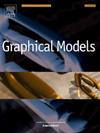RS-SpecSDF: Reflection-supervised surface reconstruction and material estimation for specular indoor scenes
IF 2.2
4区 计算机科学
Q2 COMPUTER SCIENCE, SOFTWARE ENGINEERING
引用次数: 0
Abstract
Neural Radiance Field (NeRF) has achieved impressive 3D reconstruction quality using implicit scene representations. However, planar specular reflections pose significant challenges in the 3D reconstruction task. It is a common practice to decompose the scene into physically real geometries and virtual images produced by the reflections. However, current methods struggle to resolve the ambiguities in the decomposition process, because they mostly rely on mirror masks as external cues. They also fail to acquire accurate surface materials, which is essential for downstream applications of the recovered geometries. In this paper, we present RS-SpecSDF, a novel framework for indoor scene surface reconstruction that can faithfully reconstruct specular reflectors while accurately decomposing the reflection from the scene geometries and recovering the accurate specular fraction and diffuse appearance of the surface without requiring mirror masks. Our key idea is to perform reflection ray-casting and use it as supervision for the decomposition of reflection and surface material. Our method is based on an observation that the virtual image seen by the camera ray should be consistent with the object that the ray hits after reflecting off the specular surface. To leverage this constraint, we propose the Reflection Consistency Loss and Reflection Certainty Loss to regularize the decomposition. Experiments conducted on both our newly-proposed synthetic dataset and a real-captured dataset demonstrate that our method achieves high-quality surface reconstruction and accurate material decomposition results without the need of mirror masks.

RS-SpecSDF:镜面室内场景的反射监督表面重建和材料估计
神经辐射场(NeRF)已经实现了令人印象深刻的3D重建质量使用隐式场景表示。然而,平面镜面反射在三维重建任务中提出了重大挑战。将场景分解为物理上真实的几何图形和由反射产生的虚拟图像是一种常见的做法。然而,目前的方法很难解决分解过程中的模糊性,因为它们主要依赖于镜像掩模作为外部线索。它们也无法获得精确的表面材料,这对于回收几何形状的下游应用至关重要。在本文中,我们提出了一种新的室内场景表面重建框架RS-SpecSDF,它可以忠实地重建镜面反射器,同时准确地从场景几何形状中分解反射,并在不需要镜面掩模的情况下恢复表面的精确镜面分数和漫反射外观。我们的主要想法是执行反射光线投射,并使用它作为反射和表面材料分解的监督。我们的方法是基于这样一种观察,即相机光线所看到的虚拟图像应该与光线从镜面反射后击中的物体一致。为了利用这一约束,我们提出了反射一致性损失和反射确定性损失来正则化分解。在合成数据集和实际捕获数据集上进行的实验表明,我们的方法在不需要镜像掩模的情况下获得了高质量的表面重建和准确的材料分解结果。
本文章由计算机程序翻译,如有差异,请以英文原文为准。
求助全文
约1分钟内获得全文
求助全文
来源期刊

Graphical Models
工程技术-计算机:软件工程
CiteScore
3.60
自引率
5.90%
发文量
15
审稿时长
47 days
期刊介绍:
Graphical Models is recognized internationally as a highly rated, top tier journal and is focused on the creation, geometric processing, animation, and visualization of graphical models and on their applications in engineering, science, culture, and entertainment. GMOD provides its readers with thoroughly reviewed and carefully selected papers that disseminate exciting innovations, that teach rigorous theoretical foundations, that propose robust and efficient solutions, or that describe ambitious systems or applications in a variety of topics.
We invite papers in five categories: research (contributions of novel theoretical or practical approaches or solutions), survey (opinionated views of the state-of-the-art and challenges in a specific topic), system (the architecture and implementation details of an innovative architecture for a complete system that supports model/animation design, acquisition, analysis, visualization?), application (description of a novel application of know techniques and evaluation of its impact), or lecture (an elegant and inspiring perspective on previously published results that clarifies them and teaches them in a new way).
GMOD offers its authors an accelerated review, feedback from experts in the field, immediate online publication of accepted papers, no restriction on color and length (when justified by the content) in the online version, and a broad promotion of published papers. A prestigious group of editors selected from among the premier international researchers in their fields oversees the review process.
 求助内容:
求助内容: 应助结果提醒方式:
应助结果提醒方式:


